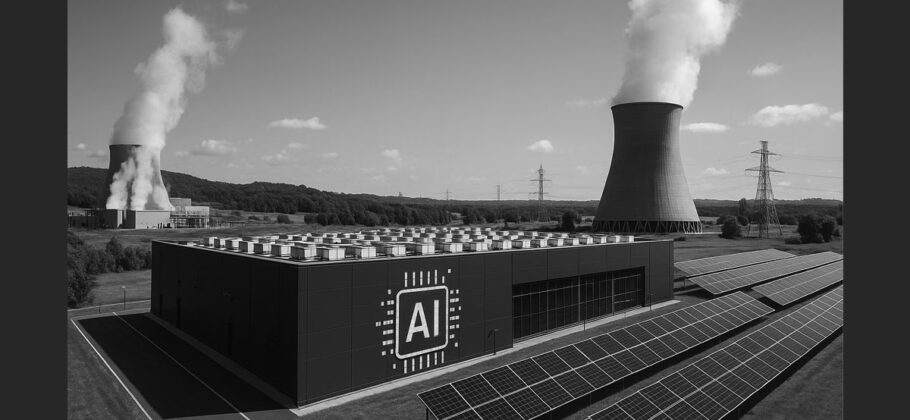Artificial intelligence is rapidly becoming one of the largest drivers of energy demand in the United States, and that is reshaping where investors are putting their money. Data centers supporting AI applications consume massive amounts of electricity, and the need for carbon-free, around-the-clock power is giving new momentum to clean technology firms. Long overlooked sectors such as nuclear and geothermal energy are now attracting both Wall Street and Silicon Valley as companies search for reliable ways to fuel the next era of computing.
The Connection Between AI and Greentech
The International Energy Agency (IEA) recently reported that global electricity use from data centers is on track to more than double by 2030. According to the report, “AI will be the most significant driver of this increase, with electricity demand from AI-optimized data centers projected to more than quadruple by 2030.” In the United States alone, the IEA projects that AI-powered data centers will account for nearly half of the country’s growth in electricity demand over the next five years.
This rising need makes technologies such as nuclear and geothermal far more appealing to investors than they were just a few years ago. Unlike wind and solar, which depend on weather, nuclear and geothermal can provide consistent baseload power twenty-four hours a day. David Brown, director of the energy transition practice at Wood Mackenzie, explained, “Nuclear is an ideal supply source for data centers, and companies are willing to pay a premium for carbon-free, round-the-clock power.”
Investment Deals Driven by AI’s Energy Demands
AI’s influence can be seen clearly in recent clean tech deals. Nuclear startup Oklo Inc. has seen its stock climb nearly 275 percent this year, while Bloom Energy, a leading fuel cell provider, is up 66 percent. TerraPower, a nuclear company founded by Bill Gates and backed by Nvidia’s venture arm, closed a $650 million funding round in the first half of 2025. BloombergNEF reported that almost a quarter of all venture capital for U.S. climate tech this year went to nuclear startups.
Technology giants are also entering long-term contracts with nuclear operators to secure power for their future data centers. Microsoft signed a deal with Constellation Energy for electricity from the Three Mile Island nuclear plant, which is expected to restart in 2027. Meta Platforms struck a similar deal with Constellation in June to purchase power from an Illinois nuclear plant. These agreements demonstrate how AI companies are directly fueling demand for nuclear electricity.
Geothermal firms are seeing renewed interest as well. Ormat Technologies has already secured power purchase agreements with utilities and community energy programs in California. Its shares have risen 29 percent this year. Ormat’s CEO Doron Blachar noted that the company expects to finalize additional contracts with data centers later in the year, crediting recent regulatory changes. “We are benefitting from faster permitting timelines and quicker responses from the federal government,” Blachar said on an investor call.
Promise and Pitfalls of AI-Driven Growth
Optimists see this wave of AI demand as a long-awaited boost for clean energy. Jeff Osborne, a senior clean energy analyst at TD Cowen, commented, “That has reinvigorated enthusiasm for companies that benefit from the trend.” Supporters argue that AI’s insatiable need for energy could finally push nuclear and geothermal into the mainstream after decades of hesitation. Pro-renewables investors believe that the technology industry’s reliance on carbon-free power creates financial incentives that align with climate goals.
However, skeptics point out that enthusiasm does not erase longstanding challenges. Nuclear plants in particular face steep costs and lengthy construction timelines. The most recent nuclear projects in the United States, Vogtle Units 3 and 4 in Georgia, ran more than ten years behind schedule and suffered $17 billion in cost overruns. As Gabriel Kra, co-founder of climate tech investment firm Prelude Ventures, explained, “Both [nuclear and geothermal] will take significant time and capital to get permitted and deployed at scale.”
Geothermal also has hurdles to overcome. Enhanced geothermal systems involve expensive drilling and carry environmental risks. A project in Basel, Switzerland caused more than 10,000 small earthquakes during hydraulic fracturing. Even with political support, geothermal electricity costs remain higher than coal or natural gas in many cases, which could limit its scalability in the near term.
Divided Perspectives
For those who see AI as a historic opportunity, the energy challenge is also a chance to build a cleaner and more resilient power grid. Fatih Birol, the IEA’s executive director, remarked, “With the rise of AI, the energy sector is at the forefront of one of the most important technological revolutions of our time. AI is a tool, potentially an incredibly powerful one, but it is up to us how we use it.”
Pessimists, on the other hand, warn that if clean tech cannot scale quickly enough, data centers may turn to natural gas to fill the gap. Kra observed, “The tools we have to scale are gas, solar, wind, batteries.” But with natural gas turbine shortages already emerging, the situation could limit the ability to produce low-cost electricity for AI companies. Nancy Pfund, managing partner at DBL Partners and an early Tesla investor, added that “it is dangerous out there for a solar and wind company right now,” as the Trump administration reduces federal support for those technologies.
Artificial intelligence has become both a challenge and an opportunity for the energy sector. The surge in electricity demand from data centers has directed billions of dollars into nuclear and geothermal companies, with investors and tech giants alike betting that these technologies can deliver carbon-free power at scale. Yet the realities of construction delays, high costs, and regulatory barriers mean the road ahead is uncertain. Whether AI becomes the catalyst that finally propels clean energy into the mainstream or exposes its limitations will depend on how quickly nuclear and geothermal can overcome their long-standing obstacles.





